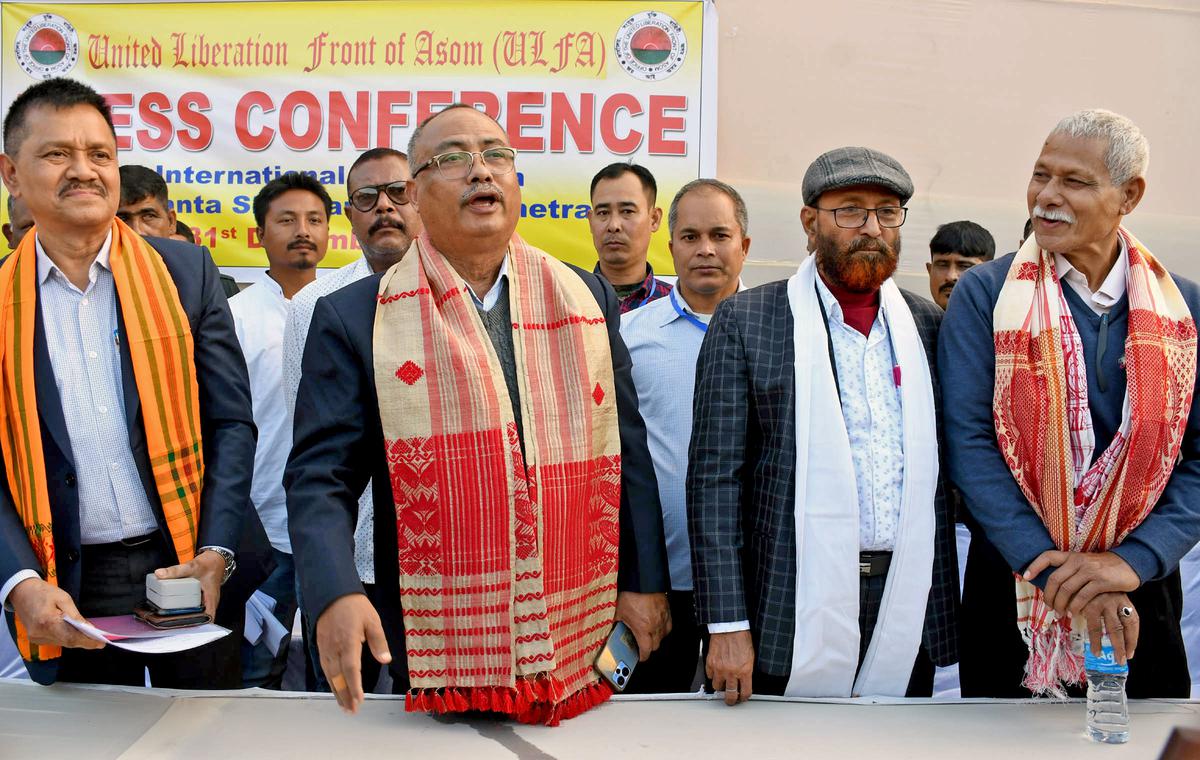Live Classes

The pro-talks faction of the United Liberation Front of Asom (ULFA) signed a tripartite peace deal with the Centre and the Assam government on December 29, 2023. The memorandum of settlement has several clauses for accelerating the State’s development and safeguarding the land and political rights of indigenous communities but a worry remains in the form of the anti-talks faction headed by Paresh Baruah.
How was the ULFA formed?
The ULFA is a by-product of the anti-foreigners Assam Agitation that began in 1979 and ended with the signing of the Assam Accord in August 1985. The fear that the Assamese and other indigenous communities would be pushed out of their own backyard by “illegal immigrants” (people from Bangladesh) one day had triggered the agitation. While social organisations and students’ bodies chose the path of agitation, a group of radicals, including Arabinda Rajkhowa, Anup Chetia, and Paresh Baruah formed the ULFA on April 7, 1979, to launch an armed struggle with the objective of establishing a sovereign Assam. The group took a decade to recruit and train its members in Myanmar, China, and Pakistan before striking with a series of abductions and executions. The government responded in 1990 with an offensive codenamed Operation Bajrang and banned the ULFA. Assam was declared a disturbed area with the imposition of the Armed Forces (Special Powers) Act.
When did the peace process start?
Counter-insurgency operations led to the arrest of 1,221 ULFA members in the early 1990s. In 1992, a group of ULFA members decided to surrender and engage in dialogue with the government. Collectively, they came to be known as SULFA or Surrendered ULFA who were later allegedly used by the State forces to help identify and execute hardliners and members of their families in what came to be known as “secret killings”. With support from terror groups such as Harkat-ul-Jihad-e-Islami and Pakistan’s Inter-Services Intelligence, the ULFA hardliners set up camps in Bangladesh and Bhutan. A military offensive by Bhutan in 2003 and the Sheikh Hasina-led Awami League’s return to power in Bangladesh in 2009 saw most of the ULFA members being flushed out from these countries. In 2005, the ULFA raised hopes of peace when it formed an 11-member People’s Consultative Group only to backtrack and unleash a fresh phase of terror. After falling in the net of the security forces in India in 2009, the leaders of the Rajkhowa-led faction signed a ceasefire agreement with the Centre in September 2011. Opposed to talks, Baruah “expelled” Rajkhowa from the ULFA in 2012. In April 2013, the anti-talks group was renamed ULFA (Independent). The pro-talks group signed the peace accord 12 years after the agreement to suspend subversive operations.
What does the peace accord offer?
According to the memorandum of settlement, the ULFA has agreed to renounce violence, disarm, disband the armed organisation, vacate their occupied camps, and participate in peaceful democratic process established by the law. Marking a shift toward non-violence, it aims to ensure the integrity of the country contrary to what the ULFA had initially demanded. The Ministry of Home Affairs will make a time-bound programme to fulfil the demands of the outfit and a committee would be formed for its monitoring. The pact underlines a comprehensive package entailing an investment of ?1.5 lakh crore for the all-round development of Assam. The most significant part of the accord is the commitment to address the political demands of the ULFA.
These include maintaining the territorial integrity of Assam through amicable settlement of boundary disputes with neighbouring States in the Northeast and continuation of the “guidelines and methodology” adopted for the delimitation exercise conducted in 2023 in future delimitation processes. The pact envisages ensuring maximum representation for indigenous communities in the 126-member Assam Assembly by keeping non-original inhabitants, primarily migrant Muslims, out. The 2023 delimitation is said to have made it impossible for non-indigenous communities to contest 106 of these seats.
Apart from the legislative safeguard, the pact seeks exemption for Assam from Section 3 of the Citizenship Act of 1955 dealing with people who have renounced Indian citizenship or whose citizenship has been terminated, to conditionally stop people of one constituency from being registered in another, and prepare an error-free National Register of Citizens, whose updated complete draft had put 19.06 lakh people out of 3.3 crore applicants on the rejection list.
What are the challenges ahead?
After the signing of the accord — the 11th since the BJP came to power in Assam with its regional partners in 2016 — Chief Minister Himanta Biswa Sarma said 90% of extremism in the State was over. Conflict specialists say the pact, provided the government shows its intent to implement the clauses, was a step in the right direction but lasting peace would be elusive unless Baruah and some 200 fighters of his ULFA (I) group talk truce.
The ULFA (I) operates from hideouts in the Sagaing Division of Myanmar. Baruah, believed to be based on the Myanmar-China border, has repeatedly said talks with the “Indian occupational forces” would be meaningless without discussing the sovereignty of Assam. The Chief Minister said the government cannot discuss sovereignty because “no one in Assam wants to secede from India” but efforts to convince Baruah to come for negotiations would continue.
Download pdf to Read More